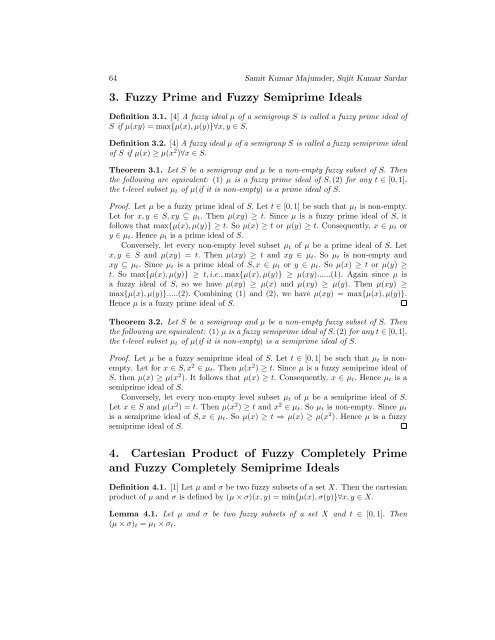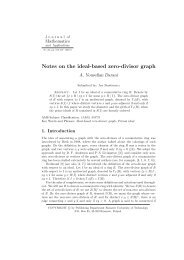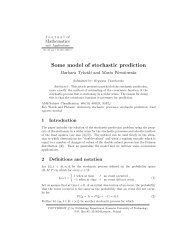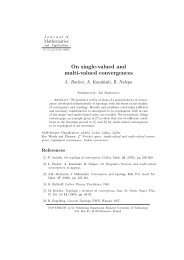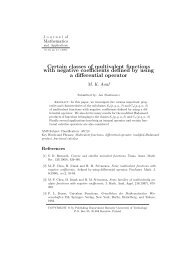On cartesian product of fuzzy prime and fuzzy semiprime ideals of ...
On cartesian product of fuzzy prime and fuzzy semiprime ideals of ...
On cartesian product of fuzzy prime and fuzzy semiprime ideals of ...
You also want an ePaper? Increase the reach of your titles
YUMPU automatically turns print PDFs into web optimized ePapers that Google loves.
64 Samit Kumar Majumder, Sujit Kumar Sardar<br />
3. Fuzzy Prime <strong>and</strong> Fuzzy Semi<strong>prime</strong> Ideals<br />
Definition 3.1. [4] A <strong>fuzzy</strong> ideal µ <strong>of</strong> a semigroup S is called a <strong>fuzzy</strong> <strong>prime</strong> ideal <strong>of</strong><br />
S if µ(xy) = max{µ(x), µ(y)}∀x, y ∈ S.<br />
Definition 3.2. [4] A <strong>fuzzy</strong> ideal µ <strong>of</strong> a semigroup S is called a <strong>fuzzy</strong> semi<strong>prime</strong> ideal<br />
<strong>of</strong> S if µ(x) ≥ µ(x 2 )∀x ∈ S.<br />
Theorem 3.1. Let S be a semigroup <strong>and</strong> µ be a non-empty <strong>fuzzy</strong> subset <strong>of</strong> S. Then<br />
the following are equivalent: (1) µ is a <strong>fuzzy</strong> <strong>prime</strong> ideal <strong>of</strong> S, (2) for any t ∈ [0, 1],<br />
the t-level subset µ t <strong>of</strong> µ(if it is non-empty) is a <strong>prime</strong> ideal <strong>of</strong> S.<br />
Pro<strong>of</strong>. Let µ be a <strong>fuzzy</strong> <strong>prime</strong> ideal <strong>of</strong> S. Let t ∈ [0, 1] be such that µ t is non-empty.<br />
Let for x, y ∈ S, xy ⊆ µ t . Then µ(xy) ≥ t. Since µ is a <strong>fuzzy</strong> <strong>prime</strong> ideal <strong>of</strong> S, it<br />
follows that max{µ(x), µ(y)} ≥ t. So µ(x) ≥ t or µ(y) ≥ t. Consequently, x ∈ µ t or<br />
y ∈ µ t . Hence µ t is a <strong>prime</strong> ideal <strong>of</strong> S.<br />
Conversely, let every non-empty level subset µ t <strong>of</strong> µ be a <strong>prime</strong> ideal <strong>of</strong> S. Let<br />
x, y ∈ S <strong>and</strong> µ(xy) = t. Then µ(xy) ≥ t <strong>and</strong> xy ∈ µ t . So µ t is non-empty <strong>and</strong><br />
xy ⊆ µ t . Since µ t is a <strong>prime</strong> ideal <strong>of</strong> S, x ∈ µ t or y ∈ µ t . So µ(x) ≥ t or µ(y) ≥<br />
t. So max{µ(x), µ(y)} ≥ t, i.e., max{µ(x), µ(y)} ≥ µ(xy)......(1). Again since µ is<br />
a <strong>fuzzy</strong> ideal <strong>of</strong> S, so we have µ(xy) ≥ µ(x) <strong>and</strong> µ(xy) ≥ µ(y). Then µ(xy) ≥<br />
max{µ(x), µ(y)}.....(2). Combining (1) <strong>and</strong> (2), we have µ(xy) = max{µ(x), µ(y)}.<br />
Hence µ is a <strong>fuzzy</strong> <strong>prime</strong> ideal <strong>of</strong> S.<br />
Theorem 3.2. Let S be a semigroup <strong>and</strong> µ be a non-empty <strong>fuzzy</strong> subset <strong>of</strong> S. Then<br />
the following are equivalent: (1) µ is a <strong>fuzzy</strong> semi<strong>prime</strong> ideal <strong>of</strong> S, (2) for any t ∈ [0, 1],<br />
the t-level subset µ t <strong>of</strong> µ(if it is non-empty) is a semi<strong>prime</strong> ideal <strong>of</strong> S.<br />
Pro<strong>of</strong>. Let µ be a <strong>fuzzy</strong> semi<strong>prime</strong> ideal <strong>of</strong> S. Let t ∈ [0, 1] be such that µ t is nonempty.<br />
Let for x ∈ S, x 2 ∈ µ t . Then µ(x 2 ) ≥ t. Since µ is a <strong>fuzzy</strong> semi<strong>prime</strong> ideal <strong>of</strong><br />
S, then µ(x) ≥ µ(x 2 ). It follows that µ(x) ≥ t. Consequently, x ∈ µ t . Hence µ t is a<br />
semi<strong>prime</strong> ideal <strong>of</strong> S.<br />
Conversely, let every non-empty level subset µ t <strong>of</strong> µ be a semi<strong>prime</strong> ideal <strong>of</strong> S.<br />
Let x ∈ S <strong>and</strong> µ(x 2 ) = t. Then µ(x 2 ) ≥ t <strong>and</strong> x 2 ∈ µ t . So µ t is non-empty. Since µ t<br />
is a semi<strong>prime</strong> ideal <strong>of</strong> S, x ∈ µ t . So µ(x) ≥ t ⇒ µ(x) ≥ µ(x 2 ). Hence µ is a <strong>fuzzy</strong><br />
semi<strong>prime</strong> ideal <strong>of</strong> S.<br />
4. Cartesian Product <strong>of</strong> Fuzzy Completely Prime<br />
<strong>and</strong> Fuzzy Completely Semi<strong>prime</strong> Ideals<br />
Definition 4.1. [1] Let µ <strong>and</strong> σ be two <strong>fuzzy</strong> subsets <strong>of</strong> a set X. Then the <strong>cartesian</strong><br />
<strong>product</strong> <strong>of</strong> µ <strong>and</strong> σ is defined by (µ × σ)(x, y) = min{µ(x), σ(y)}∀x, y ∈ X.<br />
Lemma 4.1. Let µ <strong>and</strong> σ be two <strong>fuzzy</strong> subsets <strong>of</strong> a set X <strong>and</strong> t ∈ [0, 1]. Then<br />
(µ × σ) t = µ t × σ t .


